Tek-Gnostics Archives
Tron Legacy &
The Tao
Gnostic Buddhism - Archetypical
Hero’s Journey
~ Annotated Edition ~
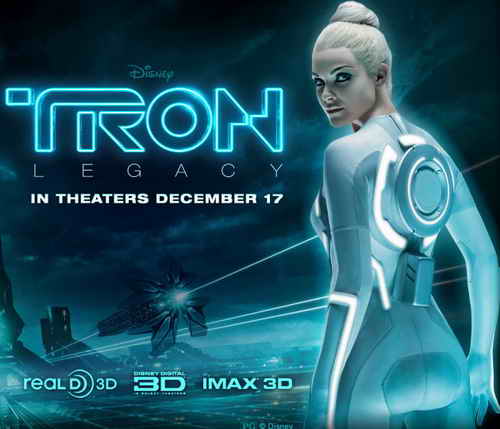 The
Tao
is alive and flowing in Disney’s Tron
Legacy, the sequel to the 1982 cult classic
Tron. Outwardly,
Tron Legacy is a visually stunning 3D adventure into the treacherous
realm of
cyberspace. Just below the story’s flashy surface, the underlying
fabric of the film is instilled with religious and philosophical
memes. As
in the 1999 film The Matrix, the mythology of choice seems to be an
amalgamation of Gnostic imagery and Buddhist methodology... Buddhist in
general and Zen Buddhist in particular. The brilliantly concise and fluid
nature of Taoism and Buddhism and the revelatory act of gnosis or knowledge
is synergistic with cyberpunk ethos.
The
Tao
is alive and flowing in Disney’s Tron
Legacy, the sequel to the 1982 cult classic
Tron. Outwardly,
Tron Legacy is a visually stunning 3D adventure into the treacherous
realm of
cyberspace. Just below the story’s flashy surface, the underlying
fabric of the film is instilled with religious and philosophical
memes. As
in the 1999 film The Matrix, the mythology of choice seems to be an
amalgamation of Gnostic imagery and Buddhist methodology... Buddhist in
general and Zen Buddhist in particular. The brilliantly concise and fluid
nature of Taoism and Buddhism and the revelatory act of gnosis or knowledge
is synergistic with cyberpunk ethos.
If the film’s
philosophy rings of Gnostic Buddhism, it’s structure follows a classic
archetypical “Hero’s Journey” format, as popularized by Joseph Campbell’s
The Hero with a Thousand Faces.
In
the sequel, Actor Jeff Bridges reprises his role as the video game visionary
Kevin Flynn, still trapped in his computer world. Apparently abandoned by
his father for 20 years, Flynn’s son Sam (Garrett Hedlund) is the reluctant
heir to the software mega-corporation,
Encom International. When Sam, now
grown, is mysteriously directed to his father’s derelict arcade, he
discovers his father’s secret study. Inadvertently, he activates a portal
(read: Star Gate) and ends up getting sucked into the same otherworldly grid
ruled by Flynn’s corrupted
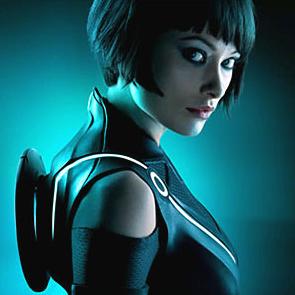 program, created in his own image, named Clu (a
digital version of a much younger Bridges).
program, created in his own image, named Clu (a
digital version of a much younger Bridges).
As
Flynn, his son and a fearless warrior program Quorra (Olivia Wilde)
contemplate escape, they are confronted by the system’s unique physics and
program flaws, including Clu (the program that Flynn created, in his own
image) and the flashy fixer
Castor (Michael Sheen)… who may or may not be a
friendly program. Also on hand is Bruce Boxleitner, reprising both his
Tron role and that of Flynn’s partner Alan Bradley.
The story-line
follows the hero’s journey
archetype, with reluctant hero accepting
the call to adventure… wise mentor providing assistance… etc. What makes the
mythology accessible is the literal story-telling approach to the Buddhist
concept of mastery of self, as depicted in Jungian interpretation. The
film’s young lead… Flynn’s son, Sam… is the typical handsome movie-star
hero. His outward appearance is classic motorcycle riding,
computer-hacking
cyberpunk. Within the Hollywood movie structure, his role follows
predictable formula. Boy meets girl… boy losses girl… boy saves girl, etc.
Buddhist Archetype
Within the context of the Hero’s Journey, Sam initially refuses the
call to adventure, as presented by his first mentor,
Alan Bradley. He then crosses the threshold via the (supernatural)
portal, and is transported to the grid, or the otherworld. It is
during his Initiation or trails that he meets (is saved by) the goddess
figure, the beautiful warrior program, Quorra. It is Quorra who delivers Sam
to the second mentor, the Tek-Zen Master, Flynn. Thus the Atonement with
the Father is accomplished.
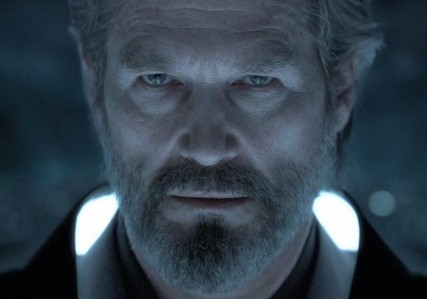 The philosophic
essence of the tale is in Flynn’s struggle within himself. The struggle of
Ego to integrate it’s many components, in Jungian terms. If “The Grid” is
allegorical to the collective unconscious, then it naturally follows that
Flynn must battle a younger version of himself… his own earlier arrogances.
This straightforward depiction is very effective in illuminating the
transition of knowledge to wisdom.
The philosophic
essence of the tale is in Flynn’s struggle within himself. The struggle of
Ego to integrate it’s many components, in Jungian terms. If “The Grid” is
allegorical to the collective unconscious, then it naturally follows that
Flynn must battle a younger version of himself… his own earlier arrogances.
This straightforward depiction is very effective in illuminating the
transition of knowledge to wisdom.
The
theatrical and mythic turning point in the story is revealed in the
“nightclub scene.” This is when Flynn resolves his inner hesitation… when he
realizes the
moment of action has arrived… and chooses the path that the hero(s) must follow. This is elegantly depicted within the film by the use
of multi media effects, conveying the presence of power (read:
chi) and true
authority of Flynn… within the grid. It is at this pivotal point in the
story… a battle scene, actually… that the poignancy of Buddhism manifests.
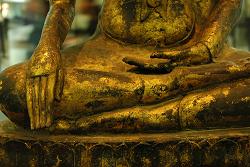 In the heat of battle at the
nightclub, Flynn suddenly appears and performs
one of the most
beautiful (and archetypical) images in Buddhist iconography… the "Earth
Touching Buddha."
In the heat of battle at the
nightclub, Flynn suddenly appears and performs
one of the most
beautiful (and archetypical) images in Buddhist iconography… the "Earth
Touching Buddha."
In
Buddhist mythology… at the moment of enlightenment… Lord Buddha was
challenged one last time by
Mara the Great Tempter (within the film…
Castor/Zuse). Mara claimed the earth as his own domain, and said that now
the Buddha had transcended this realm and should leave it. In reply, the
Buddha called the Earth to witness by
touching the ground at which the Earth
quaked in recognition of his right to be here. Within the film, this
demonstration is masterfully displayed using audio and visual imagery,
fittingly depicted as “nightclub lightshow” effects.
Gnostic
Archetype
Although much of the character’s rationale and subsequent actions appear
Buddhist inspired, the imagery within Tron Legacy may be
Gnostic in
nature. Initial symbolic parallels between Flynn as God and Clu as the
devil, is… shall we say… tempting. Clu rebels when Flynn asks him to be
subservient to the emergent life-forms, the Isotopes (it turns out that
Quorra is the sole surviving specimen), which miraculously and spontaneously
manifest within "the grid." It would naturally follow that Sam… the son…
would fulfill the
Osiris/Mithras/Jesus roll as redeemer.
“Although
people will be mostly aware of these motifs from their familiarity with
Christianity, you could find these basic symbols in many other
cosmologies. Clu seems more like the Gnostic “Demiurge” perhaps than
Satan; and the story of the Logos coming down to save the Sophia/wisdom
in humanity is also more Gnostic, although it is available (but hidden)
in regular Christian theology. And by making the creator responsible for
evil, it is morally superior and far more satisfying than the Christian
mythos, which blames everything on Satan and absolves God from
responsibility.”
- Derek
Murphy
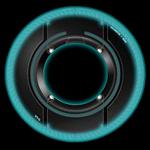 Clu
as the
Demiurge creates a compelling mythology for the creation of “The
Grid” as a sub-world of our mundane world… a wheel within a wheel of
creation. After all… Flynn made Clu in his image. The flaws within “the
grid” illustrate an imperfect world, created by an imperfect creator.
Gnostic mythology utilizes a dualistic creation motif of a transcendent,
unknowable god (Flynn) and a lesser creator god or demiurge (Clu).
The world
created by the demiurge is separated from the greater world by a dark veil
that denies access.
Clu
as the
Demiurge creates a compelling mythology for the creation of “The
Grid” as a sub-world of our mundane world… a wheel within a wheel of
creation. After all… Flynn made Clu in his image. The flaws within “the
grid” illustrate an imperfect world, created by an imperfect creator.
Gnostic mythology utilizes a dualistic creation motif of a transcendent,
unknowable god (Flynn) and a lesser creator god or demiurge (Clu).
The world
created by the demiurge is separated from the greater world by a dark veil
that denies access.
Sam,
as redeemer, is able to transcend “the grid” to the greater world of the
users. Through his intervention and decent to “the grid” he is able to
access the portal and ascend to our mundane world.
Actress Olivia
Wilde’s biggest inspiration for Quorra was the 19 year old "Maid of
Orleans" ...the 14th century heretic/hero
Joan of Arc. Born a peasant girl in France, she led the French army to
several important victories during the
Hundred Years' War. Her heresy rose
from her claim to be in direct communication with the saints
(extraterrestrial contact?), and a consequent reliance upon individual
experience of God's presence (Gnosticism) beyond the ministrations of the
priesthood and the confines of the institutional church. Wilde explains...
“That occurred to me very
early on… a good six months before we started shooting… and Joe Kosinski,
our director, immediately agreed that that was the right historical
figure to base her on, for a few reasons. She's this unlikely warrior,
very strong but compassionate, and completely led by selflessness. Also,
she thinks she's in touch with some sort of higher power and has one
foot in another world. All of these things were elements of Quorra. It
was so thrilling when I found this connection between the two people. I
thought, "Oh my God, any time I'm at a loss, I can go back to Joan of
Arc." It's really the jackpot when you hit that as an actor. Joe, to his
credit, was completely supportive of that, and we sculpted the character
in our rewrites and physical creation of Quorra to match some of these
elements of Joan of Arc”.
Modern
Myth
In addition to the Gnostic Zen ambience and beyond the psychedelic eye
candy, Tron Legacy delivers what any science fiction tale should. It
serves as “a cautionary tale” about modern technology and the ramifications
what may arise from it. Actor
Jeff Bridges acknowledged the
implication of Tron Legacy as a modern myth. In Bridge's view, the
film is essentially a warning about how the drive for technological
advancement and convenience can blind us to the cost of these innovations.
Bridges' discussion of the film's approach to technology was borderline
kōan-like…
“One of the
things that brought me to this film was the idea of helping to create a
modern-day myth to help us navigate these technological waters… I hope
that people look at this film and glean some kind of wisdom from it. We
didn't want it too cloying, and we didn't want the audience to feel like
they were being preached to... We wanted some kind of substance and
hopefully the movie will help people navigate the challenges of
technology.”
The reoccurring association of
Gnostic Buddhism and science fiction in modern story telling is indicative
of Earth’s emerging mythology. It is no accident that the cautionary tale,
illuminating the delicate partnership between Earth’s domesticated primates
and technology, resonates with many of us… for it is a mythology for the
times we find ourselves living in. The concise passages of the Tao Te Ching
and the teachings of Buddha align well with the sensibilities of the modern
technophile who, like the Gnostic, value knowledge.
This
re-occurrence… this emerging mythology is permeated with
synchronicity.
Jung’s term synchronicity is used to describe “meaningful coincidence,” or
the alignment of "universal forces" with the life experiences of an
individual. Jung coined the term “collective unconscious” to refer to that
part of a person's unconscious, which is common to all human beings.
According to Jung the collective unconscious contains archetypes, which are
forms or symbols that are manifested by all people in all cultures.
Within human experience, the collective unconscious is
quite
compatible to the Tao… the basic, eternal principle of the universe
that transcends reality and is the source of being, non-being, and change.
From a human perspective, the collective unconscious is a means of accessing
the Tao. It is a shared framework from which all humanity can utilize and
draw
inspiration. Whereas the collective unconscious is the aggregate of
humanity, the Tao is the aggregate of universe. The Tao or transcendent
force that gives rise to our physical universe is perfect. The manifest
universe is “necessarily perfect,” …finite and as such, not perfect.
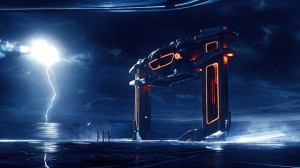 This
is the secret that Flynn has realized in his contemplation of re-integrating
with Clu. Flynn sought perfection in his virtual world. His demand of
perfection, which he programmed into Clu, did not anticipate the
unforeseeable… the spontaneous manifestation of a new life-form. The finite
or closed system could not accommodate new information, which made “the
grid” an inherently flawed realm.
This
is the secret that Flynn has realized in his contemplation of re-integrating
with Clu. Flynn sought perfection in his virtual world. His demand of
perfection, which he programmed into Clu, did not anticipate the
unforeseeable… the spontaneous manifestation of a new life-form. The finite
or closed system could not accommodate new information, which made “the
grid” an inherently flawed realm.
This may be the
final secret of Tron Legacy… that
entropy, the second law of
thermodynamics… the tendency of any system to eventually run down… is only
an inevitability in a closed system.